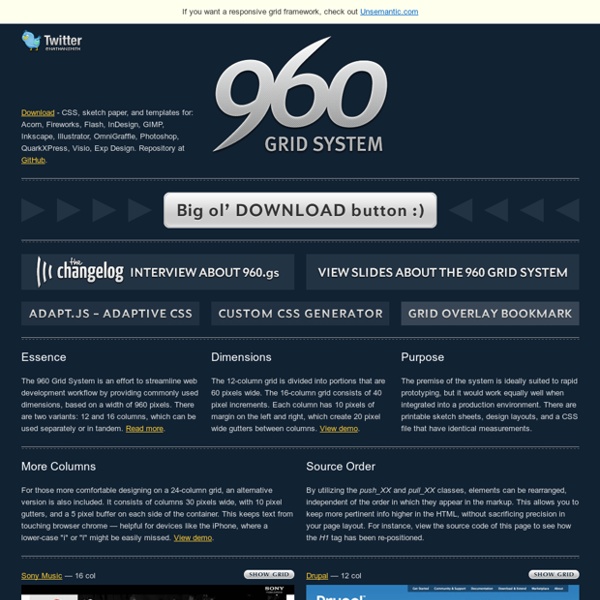



20 Useful Tools to Make Web Development More Efficient There are many available tools to help make web development projects quicker and more productive. Aside from a handy text editor or WYSIWYG editor like Dreamweaver, you can find plenty of tools and utilities that can greatly increase development speed, reduce debugging and testing time, and improve quality of the output. The tools described below are a variety of utilities, optimizers, testing, and debugging tools aimed towards helping developers create websites more efficiently. 1. The Perfect 3 Column Liquid Layout: No CSS hacks. SEO friendly. iPhone compatible. Download this layout (25kb zip file). Percentage dimensions of the holy grail layout All the dimensions are in percentage widths so the layout adjusts to any screen resolution. Vertical dimensions are not set so they stretch to the height of the content.
Remove Background Without Removing Hair « Clipping Path & Masking Service Provider Blog (Navigation privée) The 3 Rs of Photo Editing Ten megapixel Polaroids don’t essentially bring about million-dollar photos. Actually, the probability is that the nature of your Polaroid will just catch the imperfections and unwanted questions in your snaps all the more exactly and vividly. Cheat Sheets, For Everything We have collected a cheat sheet for just about everything and everyone! Video programs, Image Editing Programs, Web Languages, SEO, Social Media, and even Photography cheat sheets can be found below! Cheat sheets are a great way to have references on hand for everything from shortcuts and hot keys, to handy tips to improve your workflow. Zoomooz.js Zoomooz is: 6KB gzipped and 18KB minified. This includes everything but jQuery. Make any web page zoom. Latest version: 1.1.9 (Nov 11, 2013, hacky fix for the back and forward buttons #66) Zoomooz is a jQuery plugin for making web page elements zoom. It can be used for making Prezi like slideshows and for zooming to images or other details.
Cheat Sheets for Front-end Web Developers Cheat sheets are helpful to have around because they allow you to quickly remember code syntax and see related concepts visually. Additionally, they’re nice decorative pieces for your office and can prepare you for client questions regarding web development. In this article, you’ll find 23 excellent, print-ready cheat sheets for HTML/HTML, CSS, and JavaScript (including MooTools and jQuery).
HTML5 Video Introduction In modern browsers, adding a video to your page is as easy as adding an image. No longer do you need to deal with special plug-ins or require crazy markup, you can do it with a single element. The Ultimate Photoshop Toolbox - Noupe Design Blog Sep 07 2010 For years now, whenever designers have been asked about their go-to program for image editing and creation, one of the top answers that comes back, is Adobe Photoshop. Its generations of evolution has centered around the growth of any number of digital imaging professionals and has made this software giant a staple in the graphic design community. Since so many of us find this tool in our design arsenals, we thought we would put together a post that would have you get the most out of this dynamic imaging program.
Sad Bird Design What is this? This is an ongoing guide to creating grid systems for print, which will be continually updated. Introduction: There are plenty of guides out now online about how to create grid systems for the web, even grid generators. HTML5 HTML5 is a markup language used for structuring and presenting content for the World Wide Web and a core technology of the Internet. It is the fifth revision of the HTML standard (created in 1990 and standardized as HTML 4 as of 1997)[2] and, as of December 2012[update], is a candidate recommendation of the World Wide Web Consortium (W3C).[3] Its core aims have been to improve the language with support for the latest multimedia while keeping it easily readable by humans and consistently understood by computers and devices (web browsers, parsers, etc.). HTML5 is intended to subsume not only HTML 4, but also XHTML 1 and DOM Level 2 HTML.[2] History[edit] The Web Hypertext Application Technology Working Group (WHATWG) began work on the new standard in 2004.
17 Wonderful Free Tools To Make Designers Lives Easier! - Opensource, Free and Useful Online Resources for Designers and Developers Don't Forget to participate in a contest where you can win an amazing e-Commerce template from TemplateMonster. This is the wonderful list of 17 free and online web based tools for designers and developers which may be very helpful for you as well when you are at work. Designers and Developers will must like this list but you can also use them and will love whether you are office worker, manager, supervisor, student, home user, etc. Most of them are not very well-known but, they are really amazing in respect to their features. Just take a look at them and share your thought’s here.
Add and delete vertical space in measured intervals “Headings, subheads, block quotations, footnotes, illustrations, captions and other intrusions into the text create syncopations and variations against the base rhythm of regularly leaded lines. These variations can and should add life to the page, but the main text should also return after each variation precisely on beat and in phase.” The most common addition of vertical space on a webpage is that inserted between paragraphs. If the rhythm of the page is to be maintained, the spacing of paragraphs should be related to the basic leading. Reader Tutorial: Easy Digital Painting in Photoshop This tutorial will walk you through the simple steps used to turn a regular photograph into an interesting digital painting illustration, using Photoshop's Filter Gallery and the Smudge Tool. Depending on the photograph you choose, it shouldn't take you more than a couple of hours to complete. Before I begin, I must give a huge thanks to @kidhelios / George Auckland (my old boss from the BBC) as the source for this illustration. Preview